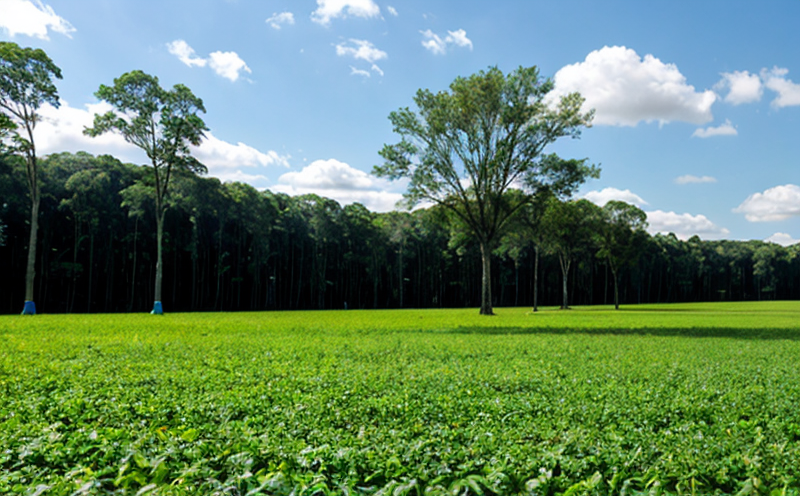Eco-Toxicological Risk Assessment in Products
The eco-toxicological risk assessment of products is a critical process that ensures consumer safety and environmental sustainability. This service involves evaluating how a product or its components might affect the environment, including soil, water, air, flora, fauna, and microorganisms during various life cycle stages—production, use, disposal, and decommissioning.
Understanding eco-toxicological risks is essential for compliance with international standards such as ISO 14001, ISO 50001, and REACH. These regulations demand that manufacturers demonstrate minimal harm to the environment throughout a product's lifecycle. By conducting thorough risk assessments, businesses can mitigate potential legal issues, enhance brand reputation, and contribute positively to environmental conservation efforts.
The complexity of this service lies in its multi-disciplinary nature, requiring expertise from toxicologists, chemists, ecotoxicologists, and materials scientists. Our team employs advanced analytical techniques like high-performance liquid chromatography (HPLC), gas chromatography-mass spectrometry (GC-MS), and Fourier transform infrared spectroscopy (FTIR) to identify potential toxins at the molecular level.
Our process includes several key steps: initial consultation, sample preparation, exposure scenarios simulation, toxicity testing, data analysis, and finally, comprehensive reporting. Each step is meticulously designed to ensure accurate identification of risks associated with specific chemical compounds or product characteristics.
In real-world applications, this assessment helps companies make informed decisions about ingredient selection, process optimization, and end-of-life management strategies. For instance, a manufacturer might use the insights gained from our eco-toxicological risk assessments to reformulate products to avoid hazardous substances or implement more sustainable packaging materials.
By integrating eco-toxicological risk assessments into their product development cycle, organizations can proactively address regulatory requirements and consumer expectations for safer and greener products. This proactive approach not only reduces operational risks but also fosters innovation in sustainable practices.
| Stage | Description |
|---|---|
| Initial Consultation | Understanding client needs, identifying relevant standards, and defining assessment scope. |
| Sample Preparation | Precise handling of samples to ensure integrity for subsequent analyses. |
| Exposure Scenarios Simulation | Crafting realistic scenarios that mimic actual product usage conditions. |
| Toxicity Testing | Performing tests using various organisms and environmental media to assess toxicity levels. |
| Data Analysis | Analyzing collected data to determine potential risks and establish safe thresholds. |
| Comprehensive Reporting | Presentation of findings in a structured format along with recommendations for mitigation strategies. |
This comprehensive approach ensures that every aspect of the product lifecycle is evaluated, providing robust evidence to support sustainable practices and regulatory compliance.
Why It Matters
The significance of eco-toxicological risk assessment in products cannot be overstated. In an era where environmental consciousness is increasingly influencing consumer behavior, businesses that prioritize sustainability are more likely to succeed. This service not only helps companies stay ahead of regulatory changes but also enhances their social responsibility profile.
Moreover, a robust eco-toxicological risk assessment can help identify and mitigate potential risks before they become significant issues. By addressing these risks early in the product development cycle, organizations can avoid costly recalls or legal battles. This proactive approach demonstrates a commitment to both consumer safety and environmental stewardship.
The findings from our assessments provide valuable insights that guide sustainable innovations. For example, companies may discover opportunities to replace harmful chemicals with safer alternatives, optimize production processes for reduced waste, or design products that are easier to recycle at the end of their useful lives. Such initiatives not only enhance product safety but also contribute positively to environmental conservation efforts.
Additionally, compliance with international standards like ISO 14001 and REACH is a critical aspect of this service. These standards set global benchmarks for environmental management systems and chemical regulations respectively. By adhering to these standards, businesses demonstrate their commitment to sustainable practices, which can significantly enhance their reputation and market competitiveness.
In conclusion, eco-toxicological risk assessment in products is essential for ensuring both consumer safety and environmental sustainability. It provides a structured framework for identifying potential risks early on, thereby enabling informed decision-making that aligns with regulatory requirements and corporate social responsibility goals.
Scope and Methodology
The scope of eco-toxicological risk assessment encompasses the evaluation of various aspects related to product safety and environmental impact. This includes identifying potential toxicants, assessing their concentrations in different media (air, water, soil), and determining exposure pathways.
- Identifying Potential Toxicants: We employ advanced analytical techniques such as HPLC, GC-MS, and FTIR to detect trace amounts of potentially harmful substances within products or their components.
- Assessing Concentrations in Media: Samples are analyzed under controlled conditions to quantify the presence of toxicants in air, water, and soil samples derived from product use scenarios.
- Determining Exposure Pathways: We simulate real-world exposure situations to understand how products interact with their surroundings and potential points of contact for human or ecological exposure.
The methodology ensures that all stages of the product lifecycle are considered, providing a holistic view of its environmental impact. This approach allows us to provide accurate and reliable risk assessments that can inform strategic decisions regarding product development and sustainability initiatives.
Competitive Advantage and Market Impact
- Proactive Compliance: By conducting eco-toxicological risk assessments early in the product lifecycle, businesses stay ahead of regulatory changes and avoid costly non-compliance issues.
- Innovation in Sustainability: Our detailed assessments help companies identify opportunities for sustainable innovations that enhance both product safety and environmental performance.
These advantages give organizations a significant competitive edge by fostering innovation while ensuring compliance with stringent environmental regulations. The market impact is profound as consumers increasingly demand products that are not only safe but also environmentally friendly. By demonstrating leadership in sustainability, businesses can attract a wider customer base and build stronger brand loyalty.





